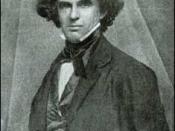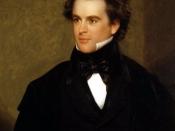- -
Since the conception of humanity, man has been fascinated with that presence which illuminates, yet cannot be touched. Mankind has brought it into his religions, giving it a great deal of importance in his creed. Following in the footsteps of his ancestors, Nathaniel Hawthorne uses light as a tool of God that illuminates the darkness of human iniquity and exposes its permanence. He studies the psychological theme of the impossibility of eradicating sin from the human heart in his novel The Scarlet Letter. The use of light in order to fortify this psychological theme confirms its significance in the novel. As though he were weaving an elaborate tapestry, Hawthorne meshes light's intense symbolism into his characters' natures until a chef d'oeuvre manifests itself upon the loom of the reader's intellect. This tapestry serves as a subtle background upon which the characters' sinful hearts are bared.
As Hawthorne navigates the reader through the passages of his dark tale, one follows Hester as she goes to Governor Bellingham's mansion.
Light is reflected by almost every aspect of the extravagant dwelling. Through the narrator's words, we see the Governor's house as Hester sees it: '...though partly muffled by a curtain, it [the hallway] was more powerfully illuminated by one of those embowed hall windows...' (Hawthorne 101). One can envision the brilliant sunlight streaming though the immense window, slicing through the facade of the Governor's feigned sanctity. Is not simplicity one of the fundamental tenets of the Puritan faith? Yet Bellingham, the very person that passed judgment on Hester and her sin is laid bare to the reader's opened eye. Here, light shows Governor Bellingham to be corrupt due to his improvident lifestyle.
In his genius, Hawthorne defines light not only as a presence, but as an animate consciousness. Still acting...


